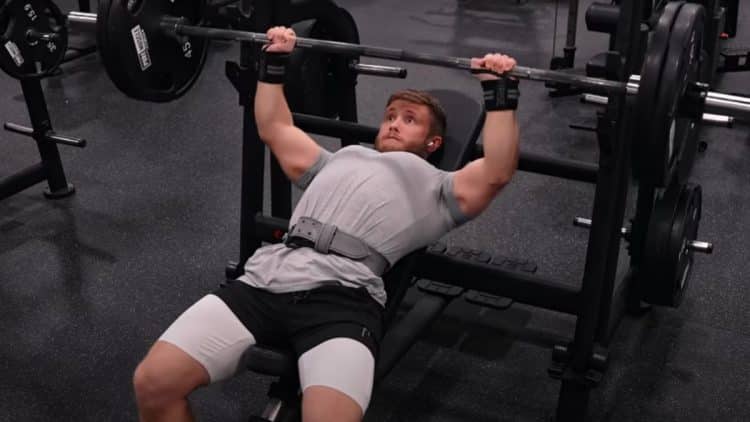Maximize muscle growth with Jeff Nippard’s effective push-day workout routine.
Jeff Nippard has laid down a near-perfect training plan with the first part of his push-pull-leg training series. It is based on minimalist training principles and he recently shared another push-day training session that compliments the first one in the series.
Nippard is a Canadian natural bodybuilder, powerlifter, and fitness expert. He is the 2012 Mr. Junior Canada and also held the Canadian national record for bench press. He has garnered a huge social media following due to his science-based bodybuilding and fitness content. At the time of this article’s publishing, Nippard has a whopping 3.81 million YouTube subscribers.
His content primarily focuses on educating the masses about the right approach to diet and training. The Canadian backs up most of his advice with findings of extensive studies and published medical material. Apart from training and study, Nippard’s knowledge comes from his formal education – a bachelor’s degree in biochemistry. Many professionals have put their faith in Nippard as he has trained several natural bodybuilders and powerlifters in men’s as well as women’s divisions.
In recent months, Jeff Nippard has shared content that deals with methods for boosting metabolism, sustainable weight management, and common nutritional mistakes. His most recent video, a push-day workout, is the fourth installment of a six-part push-pull-leg series. This training session compliments the first push-day workout of the series which we have already covered. So let’s check out the unique benefits this training session has brought for us.
View this post on InstagramGet Fitter, FasterLevel Up Your Fitness: Join our 💪 strong community in Fitness Volt Newsletter. Get daily inspiration, expert-backed workouts, nutrition tips, the latest in strength sports, and the support you need to reach your goals. Subscribe for free!
Jeff Nippard’s Push-Day Workout
Close Grip Barbell Incline Bench Press
This compound pushing exercise is the main exercise of the push day workout. Nippard suggested doing a few warm-up sets of the movement before jumping into the working sets. He introduced this as an undulating set model. The first working set should include moderate weights while the second set must be done with heavier weights. The third set, which must include lighter weights, should be done for a maximum number of reps.
“First set of eight will give you a much better idea of how much weight you should add for the following heavier set of five. Just make sure you rest for at least three to four minutes in between those sets so your pecs are feeling recovered and capable of going up in weight.”
While the first two sets are intended for getting the benefit of progressive overloading, the third set will help build mind-muscle connection when performed with lighter weights. After putting in the right amount of work in close grip incline bench press, Nippard moves on to a shoulder exercise.
Machine Shoulder Press
Incline bench press works the anterior deltoid muscles to a great extent. However, Nippard feels the need to train the shoulders with a bit more volume without taxing the body too much. As a result, a machine shoulder press is his preferred exercise.
Machines tend to be less fatiguing as you don’t need to control the weight. You can push a little closer to failure because you can use heavier weights on machines without the risk of dropping weights or getting injured.
“Obviously, machines won’t hit some of the smaller stabilizing muscles quite as well as free weights will. But as long as you’re still including some free weight exercises, I think that concern about machines pretty much goes away anyway!” Nippard said.
Keeping arms parallel to the ground after lowering the weights is sufficient to achieve the necessary range of motion during shoulder press. But Nippard prefers to go a little further down to get a deep stretch in the muscles.
“I also use a thumbless grip on these because I find it improves the mind-muscle connection,” he added.
After doing the stipulated three sets, Jeff Nippard takes on a tricep exercise next.
Floor Reset Skull Crushers
Shifting his focus to tricep work, the Canadian fitness expert performs this strength-focused tricep exercise.
“I’m including this because on my other push day of the week, I do more hypertrophy focused higher rep tricep movement on the cables.”
Nippard does floor reset skull crushers with heavier weights and maintains a low (6 to 8) rep range, putting more emphasis on progressive overload. Nippard explained the steps of performing each rep with minute details. Personally, he aims to lift the weight to full or close to full elbow flexion. He controls the weight up to half way down in the eccentric phase.
After this, he lets the weight fall down and come to a complete dead stop on the ground before initiating the next rep. This method is efficient for making strength gains. However, you can make the exercise more hypertrophy oriented by following this advice from Jeff Nippard:
“I would suggest resisting and controlling the negative all the way down to the floor from a pure hypertrophy standpoint.”
However, strength gain is Nippard’s primary objective here and he suggests applying the progressive overload principle without fail.
Bent Over Cable Flyes
Although it might be mistaken with decline cable flye, bent over pec flye is a different exercise. Arms movement in bent over cable flyes is still perpendicular to the chest and not at a lower angle. As a result, it activates all regions of pectoral muscles. But it still puts more emphasis on mid-pecs.
Level Up Your Fitness: Join our 💪 strong community in Fitness Volt Newsletter. Get daily inspiration, expert-backed workouts, nutrition tips, the latest in strength sports, and the support you need to reach your goals. Subscribe for free!
Technically, bent over cable flyes are similar to the regular cable crossover. However, Nippard argues that the cables can pull you backwards during the eccentric phase of the exercise when you are in an upright position. The constant backward pull from cable can make it harder to maintain balance and stability, limiting the amount of tension in pecs.
“So by leaning forward over the cables, you’ll be more stable since your body weight is grounded with the floor and it should allow you to direct more tension onto the pecs,” Nippard concluded.
He performs three sets of bent over cable flyes and takes up a side delt movement next.
Machine Lateral Raises
Nippard includes this high intensity medial delt exercise in the training routine. Although he performs three sets of 20 reps, those are not regular sets. He splits every set into two parts. For the first part of five reps, he performs the exercise with slow negative reps. The eccentric phase of these reps lasts for five seconds. Reps 6 to 20 are regular reps with constant tension.
“For those first five reps, the slow eccentrics should help you find your delts on the negative and you should be able to zone in on feeling the side delt fibers pulling and then, when you’ve locked that connection in, from there you can kind of just blast them with more standard constant tension reps,” Nippard explained.
There is no particular benefit of this method. However, it can be extremely beneficial for people that do not feel the side delts through regular reps.
Plate Front Raises
Jeff Nippard is not a big fan of anterior delt exercises like front raises. He feels that anterior delts get enough stimulation during compound movements and tend to be overdeveloped in comparison with lateral delts in many cases.
However, there is a way to perform front raises without putting too much emphasis on front delts. According to Nippard, you can actually work the middle segments of muscles between anterior and side delts if front raises are modified properly.
Steering the plate during front raises is an effective variation that can help engage these muscles. As explained by Nippard, side delts are engaged along with anterior delts when the arm is internally rotated during a front raise.
Dumbbell Y-raises are a good alternative to achieve the same effect for people that experience pain during the front raises with internal rotation.
Diamond Push-ups
Nippard likes to finish the workout with an all-out set as there are no sets ahead to preserve the energy for. Additionally, it gives a huge mental boost knowing that you gave it all to the training session.
The diamond push-up form forces the triceps to work harder than they do in most other push-up variations. He performs one set of diamond push-ups to failure and wraps up the training session.
The push-day workout includes following exercises, number of sets and rep range:
Warm-up
- 5 mins on the treadmill or stair master
- Dynamic stretches – arm swings, cable external rotations etc.
Close Grip Barbell Incline Bench Press
Warm-up sets
- 1st set – empty bar X 10 reps
- 2nd set – 50% working weight X 4 reps
- 3rd set – 75% working weight X 3 reps
Working sets
- 1st set – moderate working weight X 8 reps
- 2nd set – heavy working weight X 5 reps
- 3rd set – light working weight X 15 reps
Machine Shoulder Press
- 3 working sets of 10 to 12 reps
Floor Reset Skull Crushers
- 3 sets of 6 to 8 reps
Bent Over Cable Flyes
- 3 sets of 10 to 12 reps
Machine Lateral Raises
- 3 sets of 20 reps
Plate Front Raises
- 2 sets of 15 to 20 reps
Diamond Push-ups
- 1 set to failure
Jeff Nippard has ensured that his content is backed by proven data and he has done a great job of staying away from bro science. This ensures that his advice will be beneficial for most people, if not everyone. So what are you waiting for? Head over to the gym and try incorporating Jeff Nippard’s push day training session in your training.
You can watch the full workout video here, courtesy of Jeff Nippard’s personal YouTube channel:









